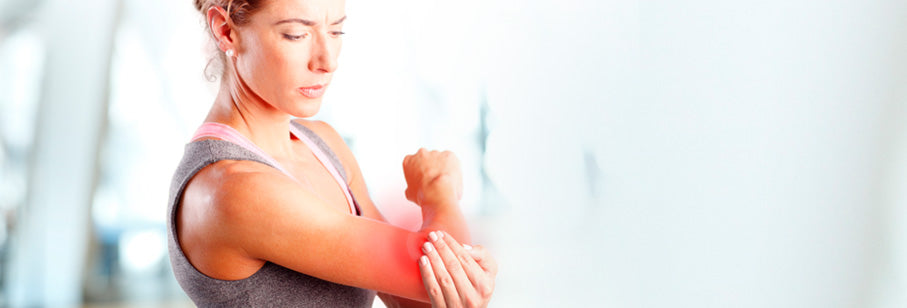It’s the middle of the night and an aching, all-consuming pain wakes you from your blissful slumber. Your whole body feels stiff and you can’t help but wince as you toss and turn. For a second you’re baffled – and then it hits you. Yesterday’s workout. You tried a new spin class, and that was after your regular weights circuit. It felt pretty good in the moment, but now you’re paying the price for your over-ambition.
Sound familiar? Post-workout soreness isn’t anything to call 9-1-1 over, but it certainly isn’t a treat, either. Keep reading to learn more about why it happens, and how you can help ease its uncomfortable effects.
Technically Speaking
The official term for post-exercise soreness is Delayed-Onset Muscle Soreness (or DOMS, for short). Our trusted friend Wikipedia describes it as “the pain and stiffness felt in muscles several hours to days after unaccustomed or strenuous exercise.” You know the feeling – a dull, aching pain that comes with tenderness and stiffness. When you try to stretch, contract, or put pressure on the affected muscle, you immediately regret it. Typically, this soreness peaks about 48 to 72 hours after a workout, when your body is in full repair mode trying to rebuild the muscle fibers you tore down during exercise.
So, What Triggers DOMS?
It usually comes down to doing something your muscles aren’t used to. Maybe you tried different exercises, engaged your muscles in new ways, or used muscles that you typically don’t use. Or (and let’s be honest here), maybe you pushed yourself too hard or had bad form. Lifting/moving awkwardly can increase your risk of soreness and even injury.
Certain movements are also shown to be more DOMs-inducing than others. According to experts, the eccentric (lengthening) movement of an exercise causes the most small-scale damage to your muscle fibers. In the case of a biceps curl, the eccentric portion would be when you slowly lower the dumbbell back down from the lift. As you do this, your bicep is hard at work in a state of contraction, making sure not to quickly drop the weight to its starting point.
Let’s Talk Relief
While some post-workout soreness is to be expected (after all, it’s called “working out” for a reason), nobody wants to be wincing in pain for a week after a gym day. Here are some easy tips to help combat the pain:
BEFORE YOUR WORKOUT:
1. Drink Lots of Water.
Staying hydrated is always a good thing, but before, during, and after exercise is especially important. Water helps to regulate your body temperature as you exercise, plus keeps you more energized and flexible. Without proper hydration, you may feel sluggish and stiff. In short, you won’t be able to perform at your best. Soreness also comes into play: if you’re dehydrated you may be more prone to muscle cramps and aches.
2. Get Enough Protein.
Protein is a crucial macronutrient for helping you build a lean, fit figure. Starting your day with a high-protein shake (such as Lean Body®) – and consuming protein at every meal – will help keep your muscles strong and healthy. It will also help prevent recurring or long-lasting soreness from exercise.
3. Do Your Research.
You don’t need to be a fitness pro, but you should have a decent idea of how to perform some basic exercises before stepping into the gym. And if you don’t, no biggie. Just scour the web for some how-to videos, or ask a friend for help. Knowledge is power, and it can set you up for ache-free success.
DURING YOUR WORKOUT:
1. Start Easy.
Time is precious, so you may be itching to head straight to those dumbbells. However, some light stretching or a quick cardio warm-up first will really pay off later. It will help increase blood flow to your muscles, prepare your body for the workout ahead, and reduce the effects of DOMS. If you ignore this important step, you’ll be at a greater risk for injury during your workout.
2. Be Mindful.
Throughout your workout, pay close attention to your body. If you’re lifting weights, keep your form slow and steady, and avoid any erratic movements. Also, be mindful of any sudden or sharp pains. You know your body best, so if something doesn’t feel right, stop and get help.
3. Don’t Compare Yourself to Others.
So, the girl beside you is killing it at the squat rack. So what? Just go at your own pace. If you go too heavy too soon, you’ll end up with a serious case of DOMS. If you’re sore for too long, you’ll end up skipping workouts and potentially falling off track. Instead, gradually increase your resistance so your muscles can adapt over time. If your competitive spirit compels you to lift heavier, find a spotter.
4. Stay Hydrated.
Keep a water bottle on hand throughout your workout, or make regular trips to the water fountain. When it comes to sports drinks, proceed with caution. These are best suited for high-intensity exercise lasting over an hour. Many of these drinks are also high in calories, sugar, and sodium. Make sure to read the nutrition label, as some sports drinks contain multiple servings in each bottle.
AFTER YOUR WORKOUT:
1. Do More Light Stretching.
It may not heal your muscle fibers, but light stretching after a workout sure does feel good. It helps release relieve tightness and improve your range of motion. Of course, play it by ear. If It feels unbearable to move, stretch, or extend your sore body part, give it more time.
2. Grab That Water Bottle…Again.
Some of your post-exercise soreness is caused by toxins. When your muscles break down, they release toxins into your body that need to be filtered out. Drinking water helps your kidneys and liver with this important waste-removal process.
3. Whip Up a Quick Protein Shake.
Since protein is the “building block” of muscle, it’s important to nourish your muscles with high-quality protein (such as Lean Body®) after a tough workout. You’ll also want to get a good dose of carbohydrates (to help replenish your body’s glycogen stores), so choose a supplement that has a nice balance of protein and carbs. Some health-promoting essential vitamins and minerals are an added bonus.
4. Take a Supplement for Recovery and Repair.
DOMS and general post-workout fatigue are common, so there is a wide range of supplements on the market to help you bounce back after your workouts. You can find the recovery and repair support you need in a product like BCAA Power. Sure, your boyfriend might use it too … but that’s OK. BCAA Power is an easy and delicious way to help repair tired muscles.
5. Enjoy a Break.
If you’re so sore you need to take a day or two off from the gym, don’t sweat it. This will give your muscles a chance to relax and heal on their own time. Time off will also prevent further damage to the affected area. If you’re still itching to exercise, do something light – like a walk or light jog around your neighborhood. These easy activities will help keep blood flowing to your sore muscles so they can heal that much faster.
6. Get Lots of Sleep.
This is a big one. While you sleep, growth hormones rush in to help stimulate muscle repair. Make sure to get plenty of ZZZs – ideally eight hours per night – so your body can do its thing to aid the affected areas.
7. Pamper Yourself.
Grab a good book and fill up your tub. A soak in a hot bath full of Epsom salts can help loosen stiff muscles and joints. You can also go the massage route. As many athletes and health professionals will attest to, a good massage can help suppress inflammation, increase blood flow, and decrease soreness.
Please Let Us Know If You Enjoyed This Article.
Your Feedback Is Important To Us
Disclaimer: This content is for informational purposes only and is not meant as medical advice, nor is it to diagnose or treat any medical condition. Please consult your physician before starting or changing your diet or exercise program. Any use of this information is at the sole discretion and responsibility of the user.













